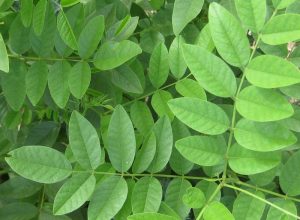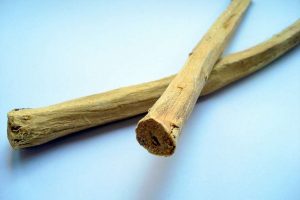Liquorice – Glycyrrhiza Glabra


Perennial herbaceous plant originally from the Mediterranean basin, Italy included, where it still spontaneously grows, its formed by an aerial part with stems just a bit higher than a metre, initially herbaceous, so with almost a woody consistency and from an underground compound, a part from the roots, from rhizomes. These, that can even be two metres long, flow horizontally, almost on the surface, and from them the stems start, or vertically; the leaves similar to the ones of the locust tree and of the ash tree (Fraxinus), are made up of 11/15 light green little leaves.
It’s rustic and it stands the cold, but it can’t be excessive and it shouldn’t be too damp; the vigorous growth, in restricted environments, can make it infesting.
TERRAIN
It vegetates well in calcareous and clayey soils and also in salty ones where rhizomes though and roots have a minor development, but with a better flavour and quality. Before planting in acid soils, to increase the ph, you can manure with fresh manure and spread a thin layer of lime, and repeat the treatment every winter.
FLORA AND FRUIT
Pleasant shrub that in the spring produces a substantial blooming made up of 4/8 little bell shaped flowers, typical of the heather family, white with a subtle perfume of honey.
The flowers pollinate themselves, both the male and female parts are present in the same flower, to improve fruit bearing a cross pollination deriving from a plant of the same variety. It’s advisable to always plant two or more plants of the same variety.
At the start of summer, groups of 4/10 small fruit begin to appear, first white, then pale pink and finally fuchsia pink that give the shrub a very pleasant appearance.
As it doesn’t have that modest acidulous component that usually distinguishes all berries, the fruit of the pink berry are very sweet therefore are very appetizing for birds and wild animals; when the fruit is ripening it’s advisable to shelter the plant with a net against birds.
USE AND HEALTH PROPERTIES
The gastronomic use of liquorice is surely known by all. The product that isn’t transformed, once dried out, is tasted by sucking the classic twigs or we find it blended for herbal teas and decoctions, while with the extract excellent sweets and ready-made for the pharmaceutical industry are obtained. Maybe few know that, the residual from the extract, if treated correctly, is a component of the fire-fighting foam and the fabrication of solar panels.
In liquorice, we can find the glycyrrhizin, a molecule with chemical-physical properties that are very important and particular. Without going into detail of the molecule and its interactions, we show you just its characteristics with values and defects for the human body.
It has a much higher sweetening power to common sugar (from 50 to 100 times more), it’s a gastro protector, indicated in the prevention and care of gastric ulcers and duodenal where it acts both directly, if in direct contact with the wound and indirectly increasing the produce of mucous to cover the walls. It has a protective action towards the liver, the pancreas and kidneys, it solves problems of hypotension (low blood pressure), it has anti-inflammatory properties, laxative, it lowers potassium in case of hyperkalaemia (low potassium) and those with excessive sweating (we remind you that with sweat we release a lot of potassium). In patients that regularly take medicines , use is not advised because the principles contained in the liquorice could interact cancelling or modifying the effects. If for healthy individuals normal consumption has beneficial effects for the liver, kidneys and the pancreas, it’s definitely not indicated for those that suffer from kidney and hepatic failure and being overweight. In Ladies, it should absolutely be avoided by those that suffer from pms and that take a contraceptive pill.
PRUNING AND CULTIVATION
Liquorice if a herbaceous plant that we can define as wild and infesting, so pruning, that isn’t necessary for the aerial parts, mainly consist in restraining the propagation of the rhizomes through cutting with a spade and eradication after.
Also manure isn’t necessary, only in soils that are not calcareous you need to add some manure, even fresh and cover the soil with lime.
The aerial part may be damaged by attacks of rust, a fungi that attacks stems and leaves and, in very hot and humid regions, from the sclerotium, a fungi that attacks the roots.
It doesn’t have parasites to be mentioned that can damage the plant, both in the aerial and underground parts.
